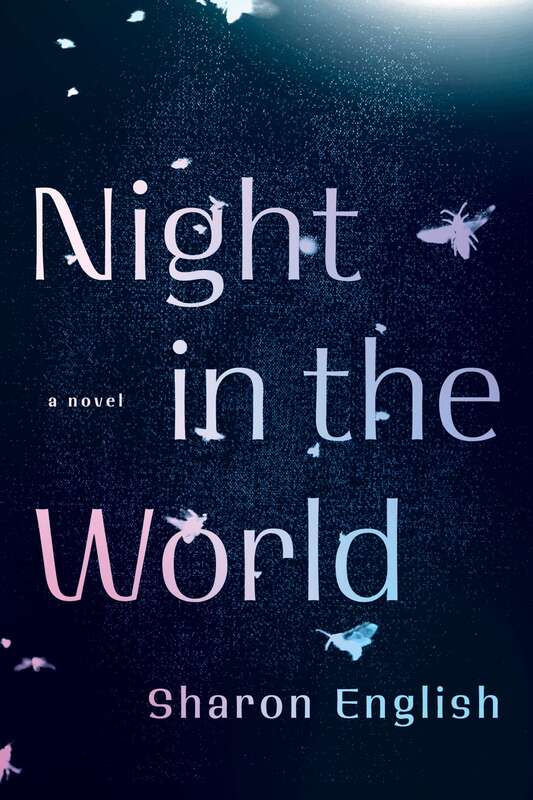Sharon English’s Night in the World
Reviewed by Marcie McCauley
|
|
In the University of Toronto library, Gabe finds entire books about moths in places she’s never been--Moths of the Maltese Islands, Moths of Madagascar, Moths of Hampshire and the Isle of Wight—but none about the moths of Canada. Sharon English’s first novel Night in the World could be that book. Except it’s not Gabe’s story alone, but also the story of two brothers.
All three characters study or work in Toronto. The Toronto that tourists visit—Kensington Market, Trinity Bellwoods Park, and the Leslie Street Spit—and the Toronto that residents recognise—Ward’s Island, the 501 Greenwood streetcar stop, and the condos at Sheppard and Yonge, but another Toronto, too: “That Toronto can be navigated this way –off road, alternating woodland, waterway and railway routes—is a revelation. From deep within the city he sees it from the edges. It feels like he’s seeing it turned inside out.” English’s preoccupation with perspective and attention-to-detail strengthens her characterisation. She is the kind of author who might list the contents of her characters’ pockets (perhaps a skill honed via two collections of short fiction) or exercise their debate muscles on political issues. Not only has she studied her characters from several directions, but they take a bird’s eye view too. One character asks: “Do you notice how people look more separate when viewed from above, even when they’re standing together in groups?” Another character answers: “It’s because you notice the space between them.” Readers are intended to notice patterns of connection and disconnection, balance and imbalance, in this novel. Characters experience losses and navigate compromises, sometimes courting and sometimes circumventing risk. On the personal level, loss is ubiquitous: “Bundle up the family and drive off like it’s any other day, with your usual sack of concerns. Tomorrow, someone will call about the ashes.” And, more broadly, threats and pressures proliferate. “Gabe considers this: invasive species, invasive people. It’s never occurred to her that the rhetoric around each can be eerily similar.” Characters reimagine and reroute. English’s settings are vivid and credible. How her characters inhabit them reveals her storyteller’s prerogative: “The trick to finding caterpillars that don’t want to be found lies in looking not for the creatures themselves, but their traces: chewed or drilled leaves, odd shapes that stand out in the mass of foliage.” She doesn’t display her thematic focus on a board with pins: wings splayed and properties itemised. She focuses more on absence than presence, backdrop rather than foreground, so the reader explores new perspectives too. In a fractured marriage, for instance, the dialogue with the spouse left behind to manage a household and young child illuminates the space previously occupied by a partner. It’s like that view of a city, turned inside out. Night in the World could be shelved with international novels by Barbara Kingsolver (the moths and butterflies that play a prominent role in Prodigal Summer, for instance), Sarah Hall (the kind of play between wild and domestic relationships in Wolf Border), and more recently, Ash Davidson’s Damnation Spring (which encapsulates the debate between invasive species that Gabe contemplates in English’s novel). With Canadian novels, it might perch with Jane Urquhart’s Sanctuary Line and Emma Hooper’s Homesick Songs (which also consider love and loss against a backdrop of wilderness), with Melissa Barbeau’s The Luminous Sea (which examines both wonder and risk in tandem), and Theresa Kishkan’s Winter Wren and Elizabeth Hay’s Late Nights on Air (for their tender exploration of the natural world and the damage people suffer from and seek to cure with memories). Structurally, English’s novel is nearly entirely devoted to a chronological, linear unfolding of these three characters’ lives. One pair has a previous connection, another pair develops a connection: as time passes, all these lives become increasingly intertwined. Ultimately, however, the story concludes with three short chapters titled “Summer’s End.” It’s a curious decision, one which recalls a challenge posed to Gabe’s moth studies: “You can’t change the method partway through a study and carry on the same course, right?” But, in fact, Gabe only appears to be changing her method; she’s actually reinvigorated to defend an earlier conviction that she feared would make her position unsustainable. English, too, only appears to change her method: for a moment, readers glimpse the whole caterpillar here, not only underleaves. But perhaps she always intended to cinch the net around her story so that readers can imagine these characters living on, in all three versions of Toronto. When Gabe is a reader, “Robarts Library becomes her post.” She creates a space for herself, which simultaneously contains the natural world without and the paged world within. “In this gruelish fortress of passageways, recesses, cubicles, staircases, numbered doors, Gabe retreats to a corner. Bare concrete, lights strung in rows, shelves of spined tomes tucked close.” But Night in the World’s conclusion flushes readers out of that corner; Sharon English’s novel solicits readers to step into another realm so they more fully inhabit their own. Marcie McCauley's work has appeared in Room, Other Voices, Mslexia, Tears in the Fence and Orbis, and has been anthologized by Sumac Press. She writes about writing at marciemccauley.com and about reading at buriedinprint.com. A descendant of Irish and English settlers, she lives in the city currently called Toronto, which was built on the homelands of Indigenous peoples - Haudenosaunee, Anishnaabeg, Huron-Wendat and Mississaugas of New Credit - land still inhabited by their descendants.
|

